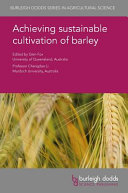

Most ebook files are in PDF format, so you can easily read them using various software such as Foxit Reader or directly on the Google Chrome browser.
Some ebook files are released by publishers in other formats such as .awz, .mobi, .epub, .fb2, etc. You may need to install specific software to read these formats on mobile/PC, such as Calibre.
Please read the tutorial at this link: https://ebookbell.com/faq
We offer FREE conversion to the popular formats you request; however, this may take some time. Therefore, right after payment, please email us, and we will try to provide the service as quickly as possible.
For some exceptional file formats or broken links (if any), please refrain from opening any disputes. Instead, email us first, and we will try to assist within a maximum of 6 hours.
EbookBell Team

5.0
88 reviewsThis collection reviews advances in research on improving barley cultivation across the value chain. Part 1 reviews advances in understanding barley physiology in such areas as plant growth, grain development and plant response to abiotic stress.
Chapters also review of current developments in exploiting genetic diversity and mapping the barley genome. Building on this foundation, the second part of the book summarises advances in breeding with chapters on breeding trial design as well as advances in molecular breeding techniques such as genome wide association studies (GWAS) and targeted induced lesions in genomes (TILLING). Part 3 looks further along the value chain at ways of optimising cultivation practices. There are chapters on post-harvest storage as well as fungal diseases, weeds and integrated methods for their management. The final part of the book assesses current developments in optimising barley for particular end uses such as malting, brewing and animal feed as well as current research on the nutraceutical properties of barley.